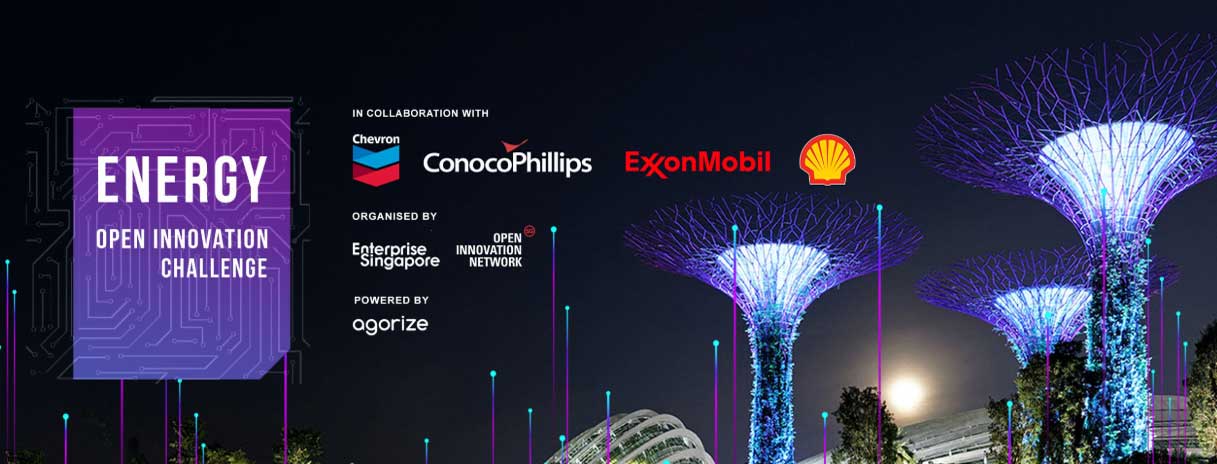| Challenge Owner(s) |
Chevron Corporation, ConocoPhillips, ExxonMobil, Shell
|
|---|---|
| Organiser(s) | Enterprise Singapore |
| Industry Type(s) |
Digital/ICT, Energy & Chemicals, Environmental Services, Marine & Offshore, Precision Engineering
|
| Opportunities and Support | Up to S$1 million of grant funding support for product development and 4 x S$25,000 prizes. |
| Application Start Date | 3 September 2020 |
| Application End Date | 6 November 2020 |
| Website | Click here to learn more |
About Challenge
Over the past century, the energy sector has been one of the significant contributors of industrial growth, fuelling our rapidly growing global economy. Singapore has developed an extensive and integrated value chain that spans refining, crackers, petrochemicals, and specialty chemicals manufacturing that is supported by R&D and innovation. The demand in Asia for energy, chemicals, and products with specialty chemical components will remain strong over the next 5 years.
Inviting startups and SMEs from across the globe - the Energy Open Innovation Challenge, organised by Enterprise Singapore in association with energy company partners, government agencies, and innovators, is now open for applications with up to S$1 million of grant funding support for product development and 4 x S$25,000 in Startup SG grant prizes to be won! Participate today with your pitch deck!
| Challenge Owner(s) | Shell, Chevron Corporation, ConocoPhillips, ExxonMobil |
|---|---|
| Industry Types(s) | Energy & Chemicals, Environmental Services, Marine & Offshore |
| Challenge Owner(s) | Shell, Chevron Corporation, ConocoPhillips, ExxonMobil |
|---|---|
| Industry Types(s) | Digital/ICT, Energy & Chemicals, Marine & Offshore |
| Challenge Owner(s) | Shell, ExxonMobil, Chevron Corporation, ConocoPhillips |
|---|---|
| Industry Types(s) | Digital/ICT, Energy & Chemicals |
| Challenge Owner(s) | Shell, Chevron Corporation, ConocoPhillips, ExxonMobil |
|---|---|
| Industry Types(s) | Digital/ICT |
| Challenge Owner(s) | ExxonMobil, ConocoPhillips, Shell, Chevron Corporation |
|---|---|
| Industry Types(s) | Electronics, Energy & Chemicals |
| Challenge Owner(s) | Shell, Chevron Corporation, ExxonMobil, ConocoPhillips |
|---|---|
| Industry Types(s) | Energy & Chemicals, Environmental Services, Marine & Offshore |
| Challenge Owner(s) | ConocoPhillips, ExxonMobil, Shell, Chevron Corporation |
|---|---|
| Industry Types(s) | Energy & Chemicals, Environmental Services, Marine & Offshore, Sea Transport |
| Challenge Owner(s) | Shell, Chevron Corporation, ConocoPhillips, ExxonMobil |
|---|---|
| Industry Types(s) | Energy & Chemicals, Environmental Services, Logistics |
| Challenge Owner(s) | Shell, ExxonMobil, Chevron Corporation, ConocoPhillips |
|---|---|
| Industry Types(s) | Energy & Chemicals, Environmental Services, Marine & Offshore, Precision Engineering |
| Challenge Owner(s) | Shell, Chevron Corporation, ExxonMobil, ConocoPhillips |
|---|---|
| Industry Types(s) | Digital/ICT, Environmental Services |
| Challenge Owner(s) | Shell, Chevron Corporation, ExxonMobil, ConocoPhillips |
|---|---|
| Industry Types(s) | Energy & Chemicals, Environmental Services, Marine & Offshore |
| Challenge Owner(s) | Shell, ExxonMobil, Chevron Corporation, ConocoPhillips |
|---|---|
| Industry Types(s) | Digital/ICT, Energy & Chemicals, Environmental Services |
| Challenge Owner(s) | Shell, ExxonMobil, Chevron Corporation, ConocoPhillips |
|---|---|
| Industry Types(s) | Energy & Chemicals, Environmental Services, Marine & Offshore |
| Challenge Owner(s) | Shell, ExxonMobil, Chevron Corporation, ConocoPhillips |
|---|---|
| Industry Types(s) | Energy & Chemicals, Environmental Services, Marine & Offshore |
| Challenge Owner(s) | Shell, ConocoPhillips, Chevron Corporation, ExxonMobil |
|---|---|
| Industry Types(s) | Energy & Chemicals, Environmental Services, Marine & Offshore |
| Challenge Owner(s) | Shell, Chevron Corporation, ConocoPhillips, ExxonMobil |
|---|---|
| Industry Types(s) | Digital/ICT |
| Challenge Owner(s) | Shell, Chevron Corporation, ExxonMobil, ConocoPhillips |
|---|---|
| Industry Types(s) | Digital/ICT, Land Transport, Logistics, Sea Transport |
For instance, pain point areas where the risk for error is high and procedure would need to be improved include:
•Planning and scheduling the use of ISO trucks: these tasks are handled by several 3PLs who each have their area of responsibility, making the process complex and lengthy
REQUIREMENTS
| Challenge Owner(s) | Shell, Chevron Corporation, ConocoPhillips, ExxonMobil |
|---|---|
| Industry Types(s) | Digital/ICT, Energy & Chemicals, Environmental Services, Marine & Offshore |
| Challenge Owner(s) | Shell, ExxonMobil, Chevron Corporation, ConocoPhillips |
|---|---|
| Industry Types(s) | Digital/ICT, Energy & Chemicals |
Sign up for the latest innovation updates
Customise your preferences to receive updates in industries you're interested in.
